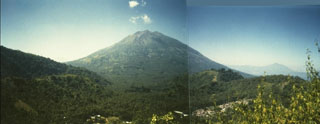Report on Iliboleng (Indonesia) — May 1986
Scientific Event Alert Network Bulletin, vol. 11, no. 5 (May 1986)
Managing Editor: Lindsay McClelland.
Iliboleng (Indonesia) Explosion; grassfires from ashfall; 570 evacuated
Please cite this report as:
Global Volcanism Program, 1986. Report on Iliboleng (Indonesia) (McClelland, L., ed.). Scientific Event Alert Network Bulletin, 11:5. Smithsonian Institution. https://doi.org/10.5479/si.GVP.SEAN198605-264220
Iliboleng
Indonesia
8.342°S, 123.258°E; summit elev. 1659 m
All times are local (unless otherwise noted)
Iliboleng erupted on 28 May at 1735. A single explosion ejected incandescent material and caused ashfall on a nearby plantation and several villages both E and W of the summit (Lamalota, Dua Muda, Tuawolo, and Kiwangona). The incandescent ashfalls caused grass fires in the very dry area (no rain reported since February) that burned 700 hectares of grass W of the volcano and 250 hectares to the E. About 570 people were evacuated from several villages after the initial explosion and grass fires, but returned to their homes 31 May.
On 2 June at 0500, weather had cleared and a white vapor cloud of ~100 m height was reported. B-type earthquakes were recorded in the area on 21 May, but no more seismic data were available.
Geological Summary. Iliboleng stratovolcano was constructed at the SE end of Adonara Island across a narrow strait from Lomblen Island. The volcano is capped by multiple, partially overlapping summit craters. Lava flows modify its profile, and a cone low on the SE flank, Balile, has also produced lava flows. Historical eruptions, first recorded in 1885, have consisted of moderate explosive activity, with lava flows accompanying only the 1888 eruption.
Information Contacts: A. Sudradjat, L. Pardyanto, and T. Casadevall, VSI.

